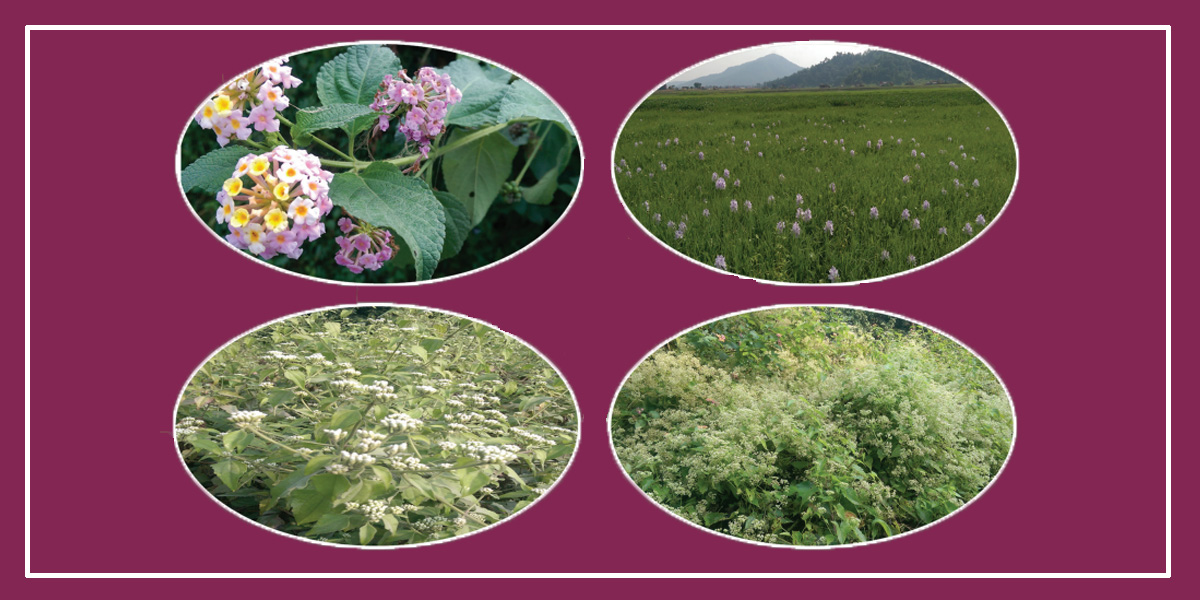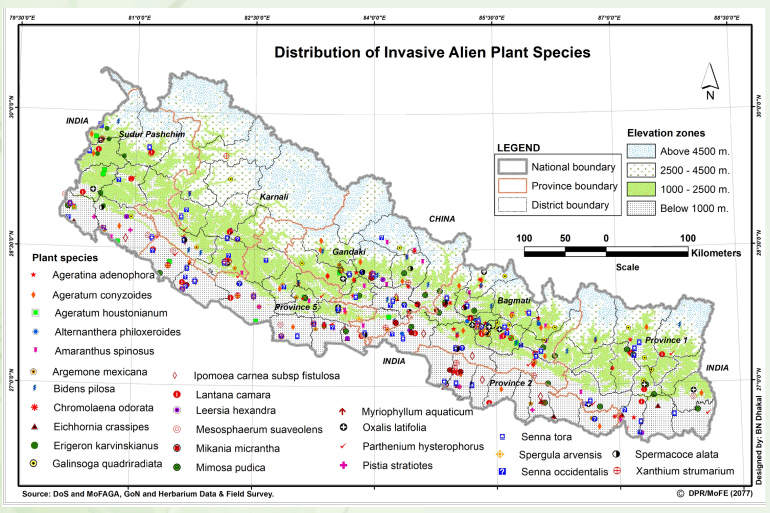
KATHMANDU: Invasive weeds have been expanding at a fast pace as large swathes of farmland remain fallow across the country.
According to the Department of Plant Resources (DoPR), invasive plant species have spread to more than 70 districts in Nepal. The DoPR has suggested to the Ministry of Forest that special attention needs to be paid to controlling these rapidly spreading species due to climate change.
Sanjeev Kumar Rai, the director general at DoPR, said these invasive weeds have started affecting the production of cash crops.
According to experts, human activities are responsible for the spread of invasive species. Invasive weed species have also spread through human movement, motor vehicles and animal manure.
A study by the International Centre for Integrated Mountain Development (ICIMOD) in 124 countries in 2016 states that external invasive species are attacking agricultural areas. Invasive species refers to weeds that intentionally or unintentionally enter farming areas. ICIMOD has also called them non-native or external species of weeds. According to the study, Nepal ranks third in terms of risks to wild fruits, rice, maize, mustard, buckwheat and other cash crops due to invasive weeds. Mongolia is first in the list, with Guinea-Bissau second and Bangladesh fourth.
ICIMOD has also suggested that the Ministry of Agriculture develop plans to control invasive weed species.
Invasive weed species have spread from 60 meters to 3600 meters altitude in Nepal. The DoPR estimates that by 2050, they will spread to areas above 4,000 meters.
Plant researcher Dr Uttam Babu Shrestha said that as invasive species affect biodiversity, native plants, wetlands, and agricultural and wild fruit production. He added that invasive weed species have spread to fields, meadows, fallow land, open land, parks, ponds, lakes and river banks. “If invasive species continue to increase, food security and human health could be at risk. Therefore, prevention measures need to be sought in time,” he said.
The ICIMOD study also states that invasive weeds negatively impact the economy, environment, and health. Such species typically have short lifespans, high growth rates and the ability to spread across many areas. Experts say that invasive species can establish dominance over native species due to their ability to produce large quantities of seeds and quickly adapt to new environments.

The department has listed plants such as Prickly amaranth, Seto Gandhe (goad weed), Thakal (Cirsium wallichii), Kalo Kuro (Hairy Bettarticks), Phuli Jhar (Fleabane), Chitlange (Peruvian daisy), Karaunte Ghas (Swam rice grass), Lajjawati (Mimosa pudica), Suga Pwankhe (Myriophyllum aquaticum), Chari Amilo (Oxalis latifolia), Kumbhika (Pistia stratiotes), Thulo Tapre (Senna occidentalis), Alu Pate (Spermacoce alata), Singapore Daisy, Wild Sunflower and Bhede Kuro (xanthium strumarium) as invasive species.
According to a study on invasive weed species conducted three years ago, Seto Gandhe is the most widespread weed having spread to 52 districts. Similar weeds like Seto Banmara (Chromolaena odorata) have spread to 23 districts, Jalkumbhi (water hyacinth( to 15, Banfanda(Lantana camara) to 34, and Lahare Banmara (Mikania micrantha) to 12 districts.
The DoPR has suggested to the forest ministry that Black Banmara (Ageratina adenophora), Blue Gandhe (Ageratum haustonianum), Jaljambu (Syzygium salicifolium), Ban Silam (Elsholtzia) and Pati Jhar (Spergula arvensis) should also be classified as invasive weeds. Ulta Kanda (Mimosa diplotricha), Lahare Banmara (Mikania micrantha), Seto Banmara (Chromolaena odorata), Kande Banmara/Banfanda (Lantana camara), and common water hyacinth (Eichhornia crassipes) are recorded worldwide as highly harmful species.
The ministry had listed invasive weeds as harmful for agricultural production in 2016. Some invasive weed species were first identified in Nepal in 1848. Invasive weed species that bloom in colorful small flower clusters appear attractive. But, the spread of invasive weeds has become a headache for farmers. According to the DoPR, the spread of invasive weeds is more prevalent in districts of Karnali Province.
Nepal’s National REDD+ Strategy (2018-2022) identified external invasive species as a significant factor in forest degradation. According to the factsheet for farmers published by the agriculture ministry in 2021, Singapore Daisy was first identified in the Panchkhal area of Kavre district in 2020. This invasive weed is now spreading at a rapid pace.
The government doesn’t have exact statistics on how much land has been affected by invasive species.


















